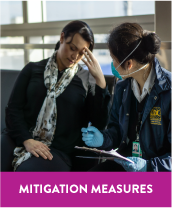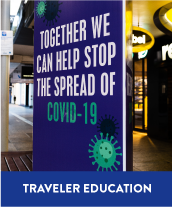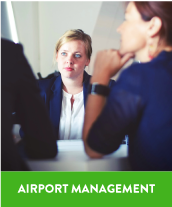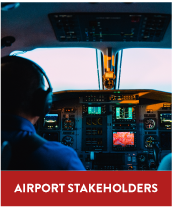Transmission: Guide
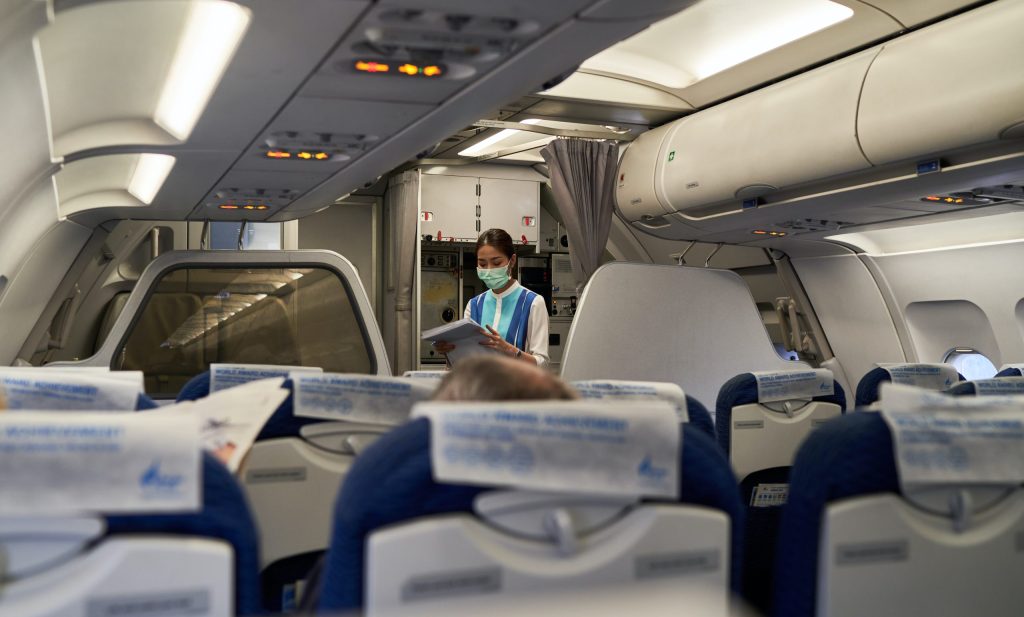
Transmission Mitigation Policies
Personal Protective Equipment
Airports can help mitigate the transmission of pathogens by issuing personal protective equipment (PPE) to employees, tenants, and customers (as appropriate) during a public health incident. This includes, but is not limited to, disposable respirators or medical procedure masks, eye protection, and gloves. Making face coverings available to and/or required for airport employees, tenants, and customers can mitigate the transmission of airborne communicable diseases.
Teleworking and In-Person Operations
Ensuring non-essential airport employees have the capability of working from home helps promote social distancing and assists with mitigating the spread of the virus. For example, during the COVID-19 pandemic, one city’s Department of Administration implemented a mandatory telework policy. All non-essential and essential employees were asked to stay home, and only mission-critical staff were to report to work on location until further notice. As employees were being brought back into the work location, plans were modified to have staggered schedules and airports limited the number of people allowed to be present in the same area, promoting social distancing. Incorporating regular telework for employees whose onsite presence is not critical can lead to fewer operational disruptions during public health incidents.
Administrative Controls
Airports should develop standard processes for prompt identification and isolation of sick individuals inside the airport facility. If an employee or tenant develops symptoms while at work, the employee’s supervisor should direct them to return home, recommend they get tested, and ask the symptomatic individual to follow up with their primary care provider. Employees, tenants, and customers should also practice hand washing, cleaning and sanitizing surfaces, and wearing PPE to mitigate the transmission of communicable diseases while in the workplace setting.
Testing/Vaccination
Vaccination and frequent testing should be encouraged for all airport employees, tenants, and customers to mitigate the spread of communicable disease. Several airports participated in onsite testing and vaccination operations.
Screening
Any health screening measures, including temperature checks, written or verbal forms, etc., should be backed by medical evidence and national standards and minimize the impact on airport operations. If conducted, pre-travel temperature screening of passengers should be done following the protocols of the relevant health authorities and should not create significant passenger flow delays or crowding, which can create additional exposure risks. The screening should include the passenger health attestation and may include visual observations conducted by trained staff. Temperature screening can be conducted upon arrival at the airport (airport entry), at the airline check-in location, or before or after entering the “sterile” gate areas. Any temperature screening of passengers arriving from international locations should not interfere with Customs and Border Protection standard operating procedures. All screening policies should be transparent and posted in advance online, and all passengers should be directly notified of screening policies before deciding whether they will attempt to fly. Industry screening protocols should also include a process to allow individuals with known reasons for having elevated temperatures, other than a positive COVID-19 test, to fly with appropriate medical documentation.
Principles of Transmission Mitigation
Personal Mitigation
Airports are considered high-exposure facilities for the spread of communicable diseases due to the volume of people from different points of origin interacting with each other. Airports can provide guidelines to staff and passengers to encourage personal mitigation strategies to prevent transmission. Physical distancing techniques, such as maintaining a 6-foot distance from others and interacting without physical touch, are highly effective mitigation strategies. It can be difficult to socially distance at airports due to the high volume of people in gate areas and checkpoints. Multiple airports have implemented physical barriers and floor markers, as well as provided social distancing guidelines for staff and customers to encourage this approach. The use of appropriate face coverings is another effective tool for personal mitigation, especially for pathogens that are airborne. The use of masks and face coverings is known to be effective in reducing transmission. Airports should consider providing information to staff, tenants, and customers on the effectiveness of mask usage, as well as provide masks as needed during public health incidents involving airborne (or potentially airborne) pathogens. Another critical mitigation technique is to apply proper hand hygiene. Airport guidelines should encourage people to clean their hands frequently, especially after they have blown their nose, sneezed, coughed, or used the toilet. Guidelines should instruct people to always wash with soap and water, or if that is unavailable, to use alcohol-based hand sanitizer.
Proposed Policies for Public Spaces, Vendors, & Employee Areas
Janitorial and Disinfecting Operations
Due to the increased cleaning frequency of the airport facilities during COVID-19 operations, areas needed to be temporarily closed off to the public, which required passengers to be directed to alternate locations in the airport. Many airports did not have designated areas to move passengers to in case of a decontamination event, which happened when an infected individual was identified in a specific area of the airport. This created additional challenges when trying to follow social distancing recommendations. The decontamination procedures allowed airports to respond accordingly and maintain a higher degree of cleanliness but negatively impacted the normal flow and boarding of passengers, requiring airports to adjust the operational pace which led to delays at times. One airport had to close off an entire Transportation Security Administration (TSA) checkpoint for cleaning after a confirmed positive COVID-19 case was identified. This cost the operation thousands of dollars in re-transiting passengers to a different TSA checkpoint which caused passengers to miss their flights or caused airlines to have schedule delays.
Banner image credit: Unsplash
